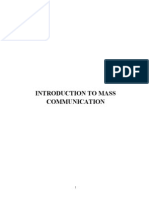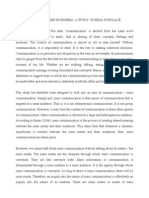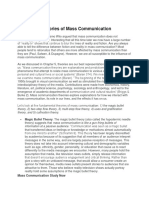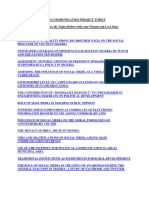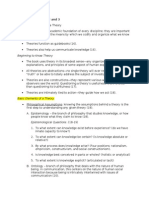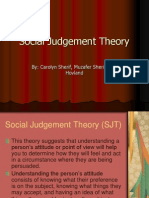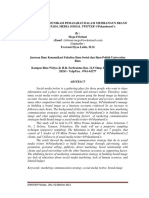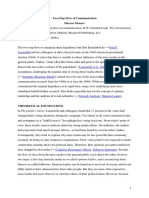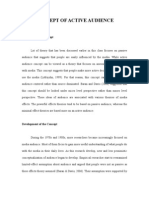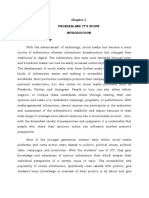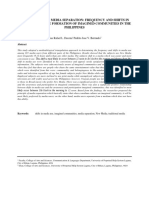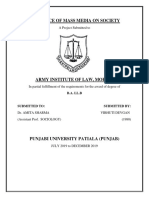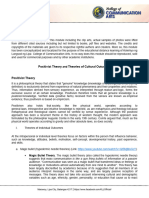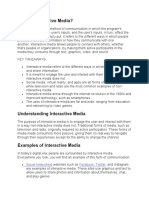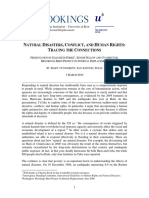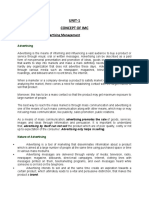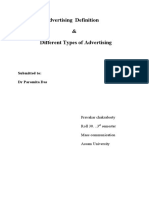Professional Documents
Culture Documents
Littlejohn, S., & Foss, K. (2009) - Encyclopedia of Communication Theor
Littlejohn, S., & Foss, K. (2009) - Encyclopedia of Communication Theor
Uploaded by
zta03Original Title
Copyright
Available Formats
Share this document
Did you find this document useful?
Is this content inappropriate?
Report this DocumentCopyright:
Available Formats
Littlejohn, S., & Foss, K. (2009) - Encyclopedia of Communication Theor
Littlejohn, S., & Foss, K. (2009) - Encyclopedia of Communication Theor
Uploaded by
zta03Copyright:
Available Formats
Encyclopedia of
Communication Theory
Media and Mass Communication Theories
Contributors: Stephen W. Littlejohn & Karen A. Foss
Print Pub. Date: 2009
Online Pub. Date: September 17, 2009
Print ISBN: 9781412959377
Online ISBN: 9781412959384
DOI: 10.4135/9781412959384
Print pages: 624-628
This PDF has been generated from SAGE knowledge. Please note that the pagination
of the online version will vary from the pagination of the print book.
University of Minnesota
Copyright ©2013 SAGE knowledge
10.4135/9781412959384.n231
University of New MexicoUniversity of New Mexico
When people think of the media, they primarily think of one of the most popular leisure
activities in the world: watching television. However, there are many other forms of
media, or mediums, which must be examined when studying mass communication.
Until recently, defining mass media was easy. Mass media were comprised of eight
traditional industries: books, newspapers, magazines, recordings, radio, movies,
television, and the Internet. Recent technological advances and societal changes,
however, challenge traditional definitions of mass communication. Mass communication
theories have also evolved with the changing nature of the media.
Although the definition of mass communication can vary from source to source, most
definitions have similar elements. Mass communication is often described or explained
by comparing it to interpersonal communication, when a source encodes a message
and sends it to a receiver via both verbal and nonverbal messages who then decodes
the message and provides feedback. In interpersonal communication, the source
and receiver are typically individuals, the channel is typically face-to-face, and the
communication is typically private. Feedback is generally direct and immediate.
Mass communication, however, is the process by which a person, group of people, or
large organization creates a message and transmits it through some type of medium
to a large, anonymous, heterogeneous audience. In mass communication, the source
is typically a professional communicator or a complex organization that incurs a great
cost. The message is typically rapid and public. And, as stated, the receiver is generally
large, heterogeneous, and anonymous. Feedback in mass communication is generally
indirect and delayed.
New technology, however, tends to blur the lines between traditional interpersonal
communication and mass communication. With a good computer and basic computer
skills, a single individual can publish his or her own professional looking magazine. With
the trend towards narrowcasting in the broadcast and cable industries, the audience
is becoming less anonymous and less heterogeneous. And with Internet channels
designed to show unique content, the audience can be relatively small.
Page 2 of 10 Encyclopedia of Communication Theory: Media and
Mass Communication Theories
University of Minnesota
Copyright ©2013 SAGE knowledge
There are also some questions as to whether other, nontraditional forms of
communication should be considered when examining mass communication. For
example, some researchers feel cell phones should be included in the definition of mass
communication. At first look it may appear that the cell phone does not fit our definition
because it is usually used for person-to-person communication. However, most current
cell phones have Internet access and are able to connect to the Web, which is typically
included in mass communication. The question is, then, does this make the cell phone a
mass medium? Researchers disagree on the issue.
History of the Study of Mass
Communication
Scholars have been studying the media and mass communication for over a century.
Although newspapers had been around for many years, it was the introduction of film
and radio that ushered in the academic study of the media as a form of communication.
It is with radio and film that literacy was no longer a barrier for enjoying the benefits of
the media. The first films were made at the end of the 1800s and in the early 1900s.
The first official radio station began operations on November 2, 1920, on the top of
Homes department store in Pittsburgh, Pennsylvania. The 1920s saw a rapid growth in
both film and radio as a form of popular entertainment.
There are three paradigms by which the media have been examined. The first
paradigm, called the [p. 624 ↓ ] powerful effects paradigm, viewed the media as very
strong and powerful; it governed from around the 1920s to the 1940s. Researchers felt
that the media (primarily radio and television) had a very immediate and direct impact
on audiences. The assumption was that the audience was passive and uncritical.
Research during this timeframe generally supported the powerful effects paradigm.
Perhaps the most famous large-scale examination of the media was The Payne Fund
Studies, a series of 13 studies undertaken between 1929 and 1932 that focused
on the effects of movies on young people. The results of these studies showed that
there were strong and powerful effects of viewing movies on children. However,
current researchers generally dismiss the results of these studies due to numerous
methodological errors.
Page 3 of 10 Encyclopedia of Communication Theory: Media and
Mass Communication Theories
University of Minnesota
Copyright ©2013 SAGE knowledge
The second paradigm, often referred to as the minimalist effects or the limited effects
paradigm, began in the 1940s and ended in the 1970s. Perhaps no study was more
influential in the paradigm shift from powerful effects to limited effects than one
conducted by Paul Lazarsfeld and his colleagues on the influence of the media in the
1940 presidential election. The researchers found that the mass media had little direct
influence on voting behavior and that it was interpersonal communication with others
that had a far greater influence. The media tended to reinforce existing behaviors rather
than change them. Reinforcing this paradigm, Wilbur Schramm conducted a series
of well-publicized, multiyear studies on the effects of television on children. Results
of Schramm's work showed that there is a complex relationship between children's
television viewing and subsequent behavior. He found it difficult to predict the effect of
watching television and questioned the causal relationship between watching television
and negative effects. There were many variables that would influence this relationship,
including the child's age, mental ability, and social situation.
Changes in society and in communication technology in the 1960s ushered in the third
paradigm, often called the cumulative effects paradigm. An increase in the number of
households with television, violent images of the civil rights movement, and a number
of new theories of media exposure caused a reevaluation of the perception of the
effects of media exposure. It is during this time that theories of long-term influence
such as social learning theory (social cognitive theory) and cultivation theory were
developed. Researchers no longer saw the effects of the media as limited or directed
and immediate, but they did see the effects as cumulative and powerful. It was the first
time that children had been exposed to television all their lives, and it was thought that
this constant, long-term viewing of violent or negative images would have profound
effects on viewers. This paradigm was supported by research during this time period,
and the idea of long-term, cumulative effects of mass media is generally supported
today.
Mass Communication Theories
There are a number of theories, some specific to mass communication and some more
general theories that have been examined when studying the mass media. A majority
of the theories used developed outside of the field of communication and then were
Page 4 of 10 Encyclopedia of Communication Theory: Media and
Mass Communication Theories
University of Minnesota
Copyright ©2013 SAGE knowledge
applied to the media by communication scholars. Although it would be impossible to
mention all the theories in this short entry, I will outline three broad categories of media
theories and briefly explain some of the major theories in each category. This list, by no
means exhaustive, includes some of the most common theories used by media scholars
in the last 50 years.
Theories about Culture and Society
The first category includes theories based on the media's effects on culture and society.
Many of these theories can be applied to things other than mass media and mass
communication. However, all have been used to examine the media's influence on the
world around us. Most of these theories focus on macrolevel media effects on culture
and society.
Media systems dependency theory is a systems-based theory that examines the mutual
dependence between the media system, the political system, and the general public.
According to this theory, each member of the dependency triad is dependent upon
and has influence over the other two. Each has influence over the other, yet each
needs the other to exist. For example, the political system needs the media system
for information dissemination and publicity and needs the general public for legitimacy
and for votes during the election season. The general public needs the political system
for authority [p. 625 ↓ ] and structure and needs the media system for entertainment
and information. Those who examine the media from a dependency perspective argue
that any systemwide examination of the media should be examined through these
dependencies.
Agenda-setting theory attempts to explain how the general public determines the most
important issues of the day. According to agenda setting, the media do not necessarily
tell people what or how they should think about an issue. However, the media (and
specifically the news media) can influence people's perception as to what is important
to consider and talk about. The more someone sees an issue being covered in the
news, the more this person will feel this is an important issue. So the influence is not
in the direction as would be expected—from the individual to the media. It is not the
individual that sets the media agenda, it is the media coverage of an issue that sets
Page 5 of 10 Encyclopedia of Communication Theory: Media and
Mass Communication Theories
University of Minnesota
Copyright ©2013 SAGE knowledge
the public agenda. This becomes increasingly distressing given the criteria that news
organizations use to determine the newsworthiness of a story.
Spiral of silence is a theory of public opinion. The theory is based on the assumption
that people do not like to feel isolated and that society tends to isolate those with
deviant or novel positions not congruent with prevailing thought. Because we fear
isolation, we constantly assess the situation around us and the perceptions of people
with whom we interact. If our opinion is that of the dominant majority, we speak out
and give our opinion. If our opinion is deviant from the dominant majority, we are more
likely to keep our opinion to ourselves. This could eventually lead to an actual change
in our position. The spiral of silence focuses on how different or deviant opinions are
suppressed in our society.
Knowledge gap hypothesis looks at the role of and use of communication technology
in society. According to those who study this hypothesis, the general public can be split
into two segments: the information rich and the information poor. The information rich
are those of a higher socioeconomic status that tend to be wealthier, better educated,
and have greater knowledge on a variety of issues than those who are information poor.
The information rich have better access to technology and are more technologically
savvy. When a new technology is introduced, the information rich tend to acquire
information and adopt the new technology at a faster rate than the information poor.
Therefore, the gap between the two population segments tends to increase rather than
decrease. This concept is very similar to the digital divide.
Cultural imperialism typically focuses on how Western nations dominate the media
around the world and how this domination can have powerful effects on other cultures.
According to the theory, the importing of cultural products (primarily film and television)
by smaller, less-developed countries can have the unintended effect of imposing
Western values and ideology—inherently imbedded in cultural products—on the
importing country. This can then have relatively large, macrolevel effects on the host
country by Americanizing it, changing or destroying the local culture.
Critical cultural studies theories focus on the social role of mass media and how the
media can be used to define power relations among various subcultures and maintain
the status quo. Critical cultural studies researchers examine how the media relate to
Page 6 of 10 Encyclopedia of Communication Theory: Media and
Mass Communication Theories
University of Minnesota
Copyright ©2013 SAGE knowledge
matters of ideology, race, social class, and gender. The media are seen not only as a
reflection of culture, but also as cultural producers themselves. The emphasis is on how
political and social structures influence mediated communication and how this affects
power relations by maintaining or supporting those with power in our society.
Theories of Influence and Persuasion
Another category of theories focuses on how the media can influence or persuade
people to think or behave in a particular way. This is perhaps the most often researched
area of the mass media. Although there are a number of theories that can be applied to
this area, below are descriptions of four of the more common theories used in the study
of mass media.
Social cognitive theory, developed primarily by psychologist Albert Ban dura in the
1960s, focuses on how and why people tend to model what they see in the media.
It is a theory that focuses on our capacity to learn without direct experience. This
observational learning is dependent upon a number of things including the subject's
ability to understand and remember what he or she saw, identification with the mediated
character, and the circumstances that would lead up to the modeling of this behavior.
Social cognitive theory is one of [p. 626 ↓ ] the most often cited and examined theories
applied to the study of the media and mass communication.
Cultivation theory research began towards the end of the 1960s in reaction to the
turmoil from the civil rights and women's movements being presented in the news.
According to cultivation researchers, television is the primary storyteller in today's
society and has become the primary source of socialization for people today. Television
also presents a mainstream, homogenous view of the world. There are consistent
themes such as high levels of violence, stereotypical gender roles, and the virtual
nonexistence of the elderly that cross all program genres. The more someone watches
television, the more he or she will perceive television reality as the same as real life.
Therefore, heavy television viewers feel the world is a more dangerous place, place a
stronger emphasis on traditional gender roles, and underestimate the number of elderly
people at greater rates than light television viewers.
Page 7 of 10 Encyclopedia of Communication Theory: Media and
Mass Communication Theories
University of Minnesota
Copyright ©2013 SAGE knowledge
The elaboration likelihood model (ELM) examines the ways in which people are
persuaded. According to the ELM, there are two routes to persuasion: the central
route and the peripheral route. If persuasion takes place via the central route, critical
examination of the situation has occurred, and the best decision with the available facts
is made. For example, a student deciding whether to go to a study group or to stay
home would examine all the facts and decide that it would be better for his grade if he
attended the study group. If a peripheral route is taken, some decision rule other than
critical thinking is used. In this example, this person could be persuaded to go to a study
group because all his friends want to go to a study group. The decision rule here would
be majority rule. Little critical thinking would occur. Persuasion via the central route
tends to last longer and be more salient than persuasion via the peripheral route.
Desensitization is one of the most often cited media theories by the popular press.
According to desensitization, repeated exposure to violent or sexual images reduces
the initial negative reaction to these images, and viewers tend to eventually become
comfortable viewing those images. Viewers are no longer bothered by seeing
somebody murdered or raped on television. The fear, then, is that these viewers will
then not have the feelings of concern, empathy, or sympathy toward victims of actual
violence. Additionally, desensitized viewers may end up seeing these deviant or criminal
behaviors as normal and common.
Media Use Theories
The final category focuses more on the motives for using the media rather than directly
examining effects. Perhaps the most studied theory in this category is uses and
gratifications theory, which focuses not necessarily on the effects of media exposure,
but more on the reasons why we choose to expose ourselves to specific forms of
media. According to uses and gratifications researchers, media users are active and
choose a medium to satisfy a specific need. If a user needs information, her or she
could read the newspaper, watch television, listen to the radio—whatever medium will
best meet the need for information. An inherent assumption here is that we all have
functional alternatives. If the need is entertainment, the user may choose another
medium. These different patterns of media choice can eventually lead to different
patterns of exposure and effects.
Page 8 of 10 Encyclopedia of Communication Theory: Media and
Mass Communication Theories
University of Minnesota
Copyright ©2013 SAGE knowledge
Mass Media and Politics
Important to note here is that the study of mass communication can often be political in
nature. A number of highly publicized events such as the school shootings at Columbine
High School in Littleton, Colorado, have caused the public and more importantly,
politicians to try to find an answer to why and how these things can happen. We want
to know why seemingly normal, well-adjusted high school boys could commit such a
heinous crime and then kill themselves. As in other high-profile mass murder cases,
the media were blamed in the attempt to find an easy answer to the question of why
this happened. The media are often blamed for various negative aspects of our society
including crime and sexual violence.
Although research indicates that the media can play a small role in these issues, it
is clear that a number of variables can lead a person to become violent, including
the person's history, personality, upbringing, and other events that have shaped that
person's life. The media are one aspect of this complex relationship. The media,
however, are often a [p. 627 ↓ ] convenient scapegoat for those looking for an easy
answer or for something or someone to blame. Anyone knowledgeable about the effects
of media should recognize this as a fallacy and understand that the media are just part
of a large group of variables that should be examined when studying violence in society.
Summary
The definition of media and mass communication is in a state of flux. New
communication technologies are blurring the lines and altering the definitions. New
theories are being developed to address the changing nature of the media. The theories
discussed here are just a sample of the ways at which researchers try to understand the
media and their influence on our lives.
Kevin J. Pearce
10.4135/9781412959384.n231
Page 9 of 10 Encyclopedia of Communication Theory: Media and
Mass Communication Theories
University of Minnesota
Copyright ©2013 SAGE knowledge
See also
Further Readings
Hetsroni, A. Overrepresented topics, underrepresented topics, and the cultivation
effect. Communication Research Reports vol. 25 (2008). pp. 200–210. http://
dx.doi.org/10.1080/08824090802237642
Hetsroni, A., Elphariach, H., Kapuza, R., and Tsfoni, B. Geographical proximity, cultural
imperialism, and the cultivation effect. Communication Monographs vol. 74 (2007). pp.
181–199. http://dx.doi.org/10.1080/03637750701390077
Jeffres, T., Neuendorf, K., Bracken, G., and Atkin, D. Integrating theoretical
traditions in media effects: Using third-person effects to link agenda-setting and
cultivation. Mass Communication & Society vol. 11 (2008). pp. 470–491. http://
dx.doi.org/10.1080/15205430802375303
Nabi, R., and Clark, S. Exploring the limits of social cognitive theory: Why negatively
reinforced behaviors on TV may be modeled anyway. Journal of Communication vol. 58
(2008). pp. 407–427. http://dx.doi.org/10.1111/j.1460-2466.2008.00392.x
Niederdeppe, J. Beyond knowledge gaps: Examining socioeconomic differences in
response to cancer news. Human Communication Research vol. 34 (2008). pp. 423–
447. http://dx.doi.org/10.1111/j.1468-2958.2008.00327.x
Scharrer, E. Media exposure and sensitivity to violence in news reports: Evidence of
desensitization? Journalism & Mass Communication Quarterly vol. 85 (2008). pp. 291–
310. http://dx.doi.org/10.1177/107769900808500205
Te'eni-Harari, T., Tampert, S., and Tehman-Wilzig, S. Information processing of
advertising among young people: The elaboration likelihood model as applied to youth.
Journal of Advertising Research vol. 47 (2007). pp. 326–340. http://dx.doi.org/10.2501/
S0021849907070341
Page 10 of 10 Encyclopedia of Communication Theory: Media and
Mass Communication Theories
You might also like
- Introduction To Mass Communication (Notes)Document70 pagesIntroduction To Mass Communication (Notes)Drifter Richardson86% (21)
- Social Information Processing Theory (CMC)Document13 pagesSocial Information Processing Theory (CMC)ANGELICA CASTILLONo ratings yet
- Newspaper Readership in Nigeria12Document13 pagesNewspaper Readership in Nigeria12Ayodeji Omilabu100% (1)
- 10-Sobolewski and Kopczewski 2017 Demand Fixed Line CommunicationDocument15 pages10-Sobolewski and Kopczewski 2017 Demand Fixed Line CommunicationRestiana FanissaNo ratings yet
- Grounding Theories of Mass CommunicationDocument8 pagesGrounding Theories of Mass Communicationucsaf samundri100% (1)
- Understanding Media and Culture An Introduction To Mass Communication 1538678536 PDFDocument697 pagesUnderstanding Media and Culture An Introduction To Mass Communication 1538678536 PDFPăun Mihnea-Dragoș100% (1)
- Mass Communication Project TopicsDocument13 pagesMass Communication Project Topicskelvin carterNo ratings yet
- Chapter 1 Summary Mass Communication TheoryDocument8 pagesChapter 1 Summary Mass Communication TheoryAnamta KhanNo ratings yet
- Craig2016.traditions in Communication TheoryDocument10 pagesCraig2016.traditions in Communication TheoryDelia ConstandaNo ratings yet
- LittlejohnDocument53 pagesLittlejohnmentalpapyrusNo ratings yet
- Digital Play and Media TransferenceDocument9 pagesDigital Play and Media TransferenceLaura OioliNo ratings yet
- The Influence of Personality Traits and User Motivation On TikTok Mobile Video UsageDocument17 pagesThe Influence of Personality Traits and User Motivation On TikTok Mobile Video UsageDerek E. BairdNo ratings yet
- Spiral of Silence TheoryDocument12 pagesSpiral of Silence TheoryWaqas MahmoodNo ratings yet
- Kombis II Memahami Komunikasi Bisnis Komunikasi Antar PribadiDocument53 pagesKombis II Memahami Komunikasi Bisnis Komunikasi Antar PribadiJohan PrachaliNo ratings yet
- Social Judgement TheoryDocument14 pagesSocial Judgement TheoryGian Patricia Ü100% (1)
- PPT ACT07 s49Document49 pagesPPT ACT07 s49elearninglsprNo ratings yet
- Newspaper AdvertisementDocument21 pagesNewspaper AdvertisementNana Yaw Bani-KwakyeNo ratings yet
- Analisis Isi - Kekerasan Verbal Dalam Sinetron PDFDocument18 pagesAnalisis Isi - Kekerasan Verbal Dalam Sinetron PDFYudi Kwe CengNo ratings yet
- Image Pada Media Sosial Twitter @pekanbaruco By:: Jalan Sekuntum 2 No. 2 Delima, Tampan, PekanbaruDocument15 pagesImage Pada Media Sosial Twitter @pekanbaruco By:: Jalan Sekuntum 2 No. 2 Delima, Tampan, Pekanbarusukses dunia akhiratNo ratings yet
- Pengaruh Media Sosial Twitter Lowkerpku Terhadap Pemenuhan Kebutuhan Informasi LDocument15 pagesPengaruh Media Sosial Twitter Lowkerpku Terhadap Pemenuhan Kebutuhan Informasi Lfaisal aditama100% (1)
- 4 Era of Mass ComDocument10 pages4 Era of Mass ComAli PuriNo ratings yet
- Research Paper Topics About Mass MediaDocument4 pagesResearch Paper Topics About Mass Medialzpyreqhf100% (1)
- Media Dependency Theory in UseDocument14 pagesMedia Dependency Theory in UseNurul Nurulatikah100% (1)
- Mass Media Influence Research PaperDocument6 pagesMass Media Influence Research Paperkiitoaulg100% (1)
- Media Dependency Theory in UseDocument13 pagesMedia Dependency Theory in UseJohana Vangchhia100% (1)
- Review of Theoretical Application of in Media WorksDocument17 pagesReview of Theoretical Application of in Media WorksizuchukwuNo ratings yet
- Media Effects TheoriesDocument1 pageMedia Effects Theories2022493978No ratings yet
- Thesis Topic Ideas For Mass Communication StudentsDocument6 pagesThesis Topic Ideas For Mass Communication Studentsdnr68wp2100% (1)
- Dependentand Interdependence TheoryDocument6 pagesDependentand Interdependence Theoryjoshua immanuelNo ratings yet
- Media EffectsDocument47 pagesMedia EffectsjellalkunNo ratings yet
- Week43BMaurer 2008 TwostepflowDocument6 pagesWeek43BMaurer 2008 TwostepflowTrần Hữu PhúcNo ratings yet
- Bianca PROJECTDocument19 pagesBianca PROJECTbiancadomingospamast12No ratings yet
- Communication TheoriesDocument3 pagesCommunication TheoriesFaisal Malik100% (2)
- Mass Media Effect TheoriesDocument3 pagesMass Media Effect TheoriesSabiha MumtazNo ratings yet
- Mass Media PDFDocument7 pagesMass Media PDFPRIYANKANo ratings yet
- Mass CommunicationDocument4 pagesMass CommunicationMia SamNo ratings yet
- Three Approaches Media ReceptionDocument31 pagesThree Approaches Media ReceptionShahid ImranNo ratings yet
- Concept of Active AudienceDocument7 pagesConcept of Active AudienceLang Mensilang86% (7)
- Hypodermic Needle TheoryDocument4 pagesHypodermic Needle TheoryJaskirat Saluja100% (1)
- Development of Mass Media Research and Method of Knowing With ExamplesDocument9 pagesDevelopment of Mass Media Research and Method of Knowing With ExamplesRana Sami0% (1)
- Chapter 1Document19 pagesChapter 1Timothy AtutuboNo ratings yet
- EAP EssayDocument4 pagesEAP EssayGiacomoNo ratings yet
- Project Proposal PDFDocument5 pagesProject Proposal PDFibrahimtongzumNo ratings yet
- EAP Essay 2Document4 pagesEAP Essay 2GiacomoNo ratings yet
- Audience: 1) The Hypodermic ModelDocument3 pagesAudience: 1) The Hypodermic ModelkellysimpsonxNo ratings yet
- Different Theories Media Effects SocietyDocument11 pagesDifferent Theories Media Effects Societyheavenly willblessNo ratings yet
- Proposal Snow Word File 2003Document11 pagesProposal Snow Word File 2003Maham AsifNo ratings yet
- Mass Communication Theories in A Time of Changing TechnologiesDocument10 pagesMass Communication Theories in A Time of Changing TechnologiesFikri AmirNo ratings yet
- Framing TheoryDocument4 pagesFraming TheoryURWAYS INDONESIA CORPORANo ratings yet
- Media Systemts Depednency TheoryDocument1 pageMedia Systemts Depednency TheorySaettoNo ratings yet
- Midterms - Com TheoriesDocument6 pagesMidterms - Com TheoriesJohn Cavin SabonsolinNo ratings yet
- Understanding Mass Media and Mass CommunicationDocument12 pagesUnderstanding Mass Media and Mass Communication조명진No ratings yet
- Decena Decena Bermudo ImradDocument20 pagesDecena Decena Bermudo ImradEli DecenaNo ratings yet
- Aurilya Kanzha Nabila TMKBDocument2 pagesAurilya Kanzha Nabila TMKBkanzhanabilaNo ratings yet
- Media Sociology-Fall 2019 - MIDTERM ExamDocument24 pagesMedia Sociology-Fall 2019 - MIDTERM ExamNourah Basel100% (1)
- What Do Communication Scholars Mean When They Speak of Media EffectsDocument9 pagesWhat Do Communication Scholars Mean When They Speak of Media EffectsC for CourageNo ratings yet
- ARGUEDAS Et Al. - Echo Chambers Filter Bubbles and Polarisation A Literature ReviewDocument42 pagesARGUEDAS Et Al. - Echo Chambers Filter Bubbles and Polarisation A Literature ReviewLeonardo MonteiroNo ratings yet
- Jourlanism AssignmentDocument7 pagesJourlanism AssignmentJahidul hoqueNo ratings yet
- Sociology ProjectDocument19 pagesSociology Projectvanikhanna2001No ratings yet
- Upload 2Document79 pagesUpload 2uzair jrNo ratings yet
- Thesis Statement Mass MediaDocument6 pagesThesis Statement Mass Mediasew0m0muzyz3100% (1)
- Attachment BBDocument6 pagesAttachment BBVeronica Beatrice Barbosa LumberaNo ratings yet
- What Is Interactive Media1Document4 pagesWhat Is Interactive Media1Jerry IntongNo ratings yet
- Group 4Document12 pagesGroup 4Aria FischaNo ratings yet
- Thesis Topic Related To Mass MediaDocument6 pagesThesis Topic Related To Mass Mediagbv7kahm100% (2)
- Theory and Practice in The Third WorldDocument6 pagesTheory and Practice in The Third Worldzta03No ratings yet
- Textbook Writing TutorialDocument17 pagesTextbook Writing Tutorialzta03No ratings yet
- Baarveld, Marlijn Smit, Marnix Dewulf, Geert - Negotiation Processes in Urban Redevelopment Projects - Dealing WithDocument23 pagesBaarveld, Marlijn Smit, Marnix Dewulf, Geert - Negotiation Processes in Urban Redevelopment Projects - Dealing Withzta03No ratings yet
- International Journal of Disaster Risk Reduction Volume Issue 2016 (Doi 10.1016 - J.ijdrr.2016.04.001) Xu, Jiuping Wang, Ziqi Shen, Feng Ouyang, Chi Tu, Yan - Natural Disasters and Social ConflicDocument17 pagesInternational Journal of Disaster Risk Reduction Volume Issue 2016 (Doi 10.1016 - J.ijdrr.2016.04.001) Xu, Jiuping Wang, Ziqi Shen, Feng Ouyang, Chi Tu, Yan - Natural Disasters and Social Confliczta03No ratings yet
- Heikkila Cairney Proof 24 4 17Document27 pagesHeikkila Cairney Proof 24 4 17zta03No ratings yet
- 0303 Natural Disasters FerrisDocument9 pages0303 Natural Disasters Ferriszta03No ratings yet
- 0059 - Conflict Analysis - Method PDFDocument12 pages0059 - Conflict Analysis - Method PDFzta03No ratings yet
- Imsakiyah Ramadhan 1440 H (2019) Kota Mataram, Propinsi Nusa Tenggara Barat, IndonesiaDocument2 pagesImsakiyah Ramadhan 1440 H (2019) Kota Mataram, Propinsi Nusa Tenggara Barat, Indonesiazta03No ratings yet
- Black Vipers Windows 10 Service Configurations Black ViperDocument42 pagesBlack Vipers Windows 10 Service Configurations Black Viperzta03No ratings yet
- 22, 2015 at Library - Periodicals Dept On May Downloaded FromDocument2 pages22, 2015 at Library - Periodicals Dept On May Downloaded Fromzta03No ratings yet
- Form FDocument1 pageForm Fzta03No ratings yet
- Medicine, Conflict and Survival: To Cite This Article: Frank Boulton (2011) Contemporary Conflict Resolution, MedicineDocument5 pagesMedicine, Conflict and Survival: To Cite This Article: Frank Boulton (2011) Contemporary Conflict Resolution, Medicinezta03No ratings yet
- Journalism & Mass Communication IDocument5 pagesJournalism & Mass Communication ISAISHA CHITKARANo ratings yet
- Definition Mass Com.Document7 pagesDefinition Mass Com.manojNo ratings yet
- AdvertisingDocument38 pagesAdvertisingShradha SaxenaNo ratings yet
- Media and Information Literacy: Quarter 1 - Module 1 Week 1Document31 pagesMedia and Information Literacy: Quarter 1 - Module 1 Week 1Racel FerrerNo ratings yet
- AssignmentsDocument9 pagesAssignmentsCelsozeca2011No ratings yet
- How Mass Communication Influence Our Lives Especially The Children. Discuss Advantages and DisadvantagesDocument1 pageHow Mass Communication Influence Our Lives Especially The Children. Discuss Advantages and DisadvantagesAshima SoodNo ratings yet
- Book Review On Communication TheoriesDocument7 pagesBook Review On Communication TheoriesJessica Bacolta JimenezNo ratings yet
- Advert Copy and Layout PDFDocument15 pagesAdvert Copy and Layout PDFAbdulgafar OpeyemiNo ratings yet
- Principles and Practices of Journalism To English-1Document38 pagesPrinciples and Practices of Journalism To English-1Birmeta FayeraNo ratings yet
- Running Head: Gatekeeping Theory As Applied in Social Domains 1Document7 pagesRunning Head: Gatekeeping Theory As Applied in Social Domains 1Titus MaiyoNo ratings yet
- Ad and IMC Chapter 5 NotesDocument61 pagesAd and IMC Chapter 5 Notesteagan.f02No ratings yet
- Fundamentals of Mass CommunicationDocument17 pagesFundamentals of Mass CommunicationAkshitaNo ratings yet
- Week 2 - Media and Information Literacy - SLAS 2Document12 pagesWeek 2 - Media and Information Literacy - SLAS 2do san namNo ratings yet
- Advertising Definition & Different Types of Advertising: Submitted To: DR Paromita DasDocument8 pagesAdvertising Definition & Different Types of Advertising: Submitted To: DR Paromita DaspravakarchakNo ratings yet
- Media and Information LiteracyDocument16 pagesMedia and Information LiteracyNienar SyNo ratings yet
- BscsDocument44 pagesBscsAamir MehmoodNo ratings yet
- Impact of TV Commercial On Consumer BehaviourDocument91 pagesImpact of TV Commercial On Consumer BehaviourprasanjeetbNo ratings yet
- Sociology of MediaDocument5 pagesSociology of MediaDILIP JAINNo ratings yet
- PDF 6 851-ARTS-2019 PDFDocument58 pagesPDF 6 851-ARTS-2019 PDFDatta GodmaleNo ratings yet
- L KFD AskfDocument284 pagesL KFD AskfSonam TobgyalNo ratings yet
- Eight Essential Components of CommunicationDocument7 pagesEight Essential Components of CommunicationAlimushwan AdnanNo ratings yet
- Name of Instructor Email: Mobile Phone (Class Representatives)Document19 pagesName of Instructor Email: Mobile Phone (Class Representatives)Ieleen MutabingwaNo ratings yet
- PersonalityDocument1 pagePersonalityaiman0% (1)
- COURSE OUTLINE PHD Mass Communication and JournalismDocument1 pageCOURSE OUTLINE PHD Mass Communication and JournalismGabriel SerbanNo ratings yet
- Mass Communication Theories (Blog)Document1 pageMass Communication Theories (Blog)Sarvangi MehtaNo ratings yet
